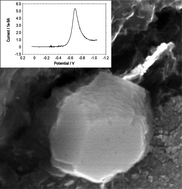Themed collection Highlighting analytical science in France, Italy and Spain

AFM , SECM and QCM as useful analytical tools in the characterization of enzyme -based bioanalytical platforms
A review of the use of AFM, SECM and QCM as analytical tools in the characterization of enzyme-based bioanalytical platforms is presented.

Analyst, 2010,135, 1878-1903
https://doi.org/10.1039/C0AN00120A
Homogeneous assays using aptamers
This review is the first entirely dedicated to aptamer- and aptazyme-based homogeneous assays carried out in a solution phase.

Analyst, 2011,136, 257-274
https://doi.org/10.1039/C0AN00281J
Plasma-based mass spectrometry for simultaneous acquisition of elemental and molecular information
Recent developments in plasma-based mass spectrometric instrumentation for integrated (elemental and molecular) chemical speciation studies are presented.

Analyst, 2011,136, 246-256
https://doi.org/10.1039/C0AN00581A
Fourier transform mass spectrometry for metabolome analysis
We evaluate the improvements provided for metabolomics by different types of FT/MS instruments, together with the ability of these platforms to cover the various analytical requirements of metabolomics.

Analyst, 2010,135, 2203-2219
https://doi.org/10.1039/C0AN00021C
Intracellular magnesium detection: imaging a brighter future
The state of the art and future developments in intracellular magnesium detection by fluorescent sensors and live imaging are discussed.

Analyst, 2010,135, 1855-1866
https://doi.org/10.1039/C0AN00087F
Functionalization of single-walled carbon nanotubes for direct and selective electrochemical detection of DNA
Hybridization of the complementary DNA sequence breaks interactions between the redox probe and the DNA probe, which speeds-up electron transfer.

Analyst, 2011,136, 1023-1028
https://doi.org/10.1039/C0AN00486C
Study of the capillary electrophoresis profile of intact α-1-acid glycoprotein isoforms as a biomarker of atherothrombosis
Statistical analysis shows that the CE profile of intact AGP purified by immunoaffinity chromatography from plasma is a potential biomarker of atherothrombosis.

Analyst, 2011,136, 816-822
https://doi.org/10.1039/C0AN00320D
New nanostructured electrochemical biosensors based on three-dimensional (3-mercaptopropyl)-trimethoxysilane network
Electrochemical response and morphological characterization by SEM and AFM of a new nanostructured biosensor based on three-dimensional (3-mercaptopropyl)-trimethoxysilane network.

Analyst, 2011,136, 340-347
https://doi.org/10.1039/C0AN00475H
Opto-electrochemical nanosensor array for remote DNA detection
A high-density array of opto-electrochemical nanosensors is presented for remote DNA detection through a nanostructured optical fiber bundle.

Analyst, 2011,136, 327-331
https://doi.org/10.1039/C0AN00501K
DNA hybridization induced selective encapsulation of small dye molecules in dendrimer based microcapsules
A novel approach for selectively encapsulating Cy5 dye molecules via DNA hybridization in cationic phosphorus dendrimers (G4+)/polystyrenesulfonate (PSS) microcapsules has been developed.

Analyst, 2010,135, 2939-2944
https://doi.org/10.1039/C0AN00334D
In situ identification and imaging of bacterial polymer nanogranules by infrared nanospectroscopy
The AFM-IR technique using an IR laser and AFM is a tool suited to chemical analysis at the nanometric scale. The identification and imaging of 50–400 nm size polyhydroxybutyrate (PHB) granules inside a single Rhodobacter capsulatus bacterium illustrate the exciting potentiality of this new photothermal near-field technique.

Analyst, 2010,135, 2540-2545
https://doi.org/10.1039/C0AN00290A
Ultrasensitive optical detection of hydrogen peroxide by triggered activation of horseradish peroxidase
Reconstitution of hemin di(N,N′-acetylhydrazide) with apo horseradish peroxidase and hydrogen peroxide for the ultra-sensitive detection of H2O2 and glucose oxidase.

Analyst, 2010,135, 2291-2295
https://doi.org/10.1039/C0AN00095G
Viable route for switching of an engineered silica surface using Cu2+ ions at sub-ppm levels
The novel monolayer architecture allows specific reversible switching between two states using Cu2+ ions as input and the absorbance intensity as output. Switching is straightforward and the optical read-out fast.

Analyst, 2010,135, 2273-2279
https://doi.org/10.1039/C0AN00364F
Disposable immunosensor for cortisol using functionalized magnetic particles
A novel electrochemical immunosensor using screen-printed carbon electrodes and functionalized magnetic particles was developed for the determination of cortisol.

Analyst, 2010,135, 1926-1933
https://doi.org/10.1039/C0AN00206B
Influence of cell geometry and number of replicas in the reproducibility of whole cell FTIR analysis
This paper shows for the first time the effects of cell shape and dimensions on the spectra quality and variability.

Analyst, 2010,135, 2099-2105
https://doi.org/10.1039/C0AN00127A
Non-linear multivariate curve resolution analysis of voltammetric pH titrations
Non-linearity correction in voltammetric pH titrations using shape constraints for modelling the shifts in peak potentials.

Analyst, 2010,135, 1653-1662
https://doi.org/10.1039/C0AN00088D
Screen-printed microsystems for the ultrasensitive electrochemical detection of alkaline phosphatase
The fabrication of a low cost, easy to manufacture microsystem and its application to achieve ultrasensitive electrochemical detection of alkaline phosphatase is herein described.

Analyst, 2010,135, 1276-1281
https://doi.org/10.1039/C0AN00001A
Polymers with embedded chemical indicators as an artificial olfactory mucosa
Olfactory mucosa inspired a novel approach to chemical sensors. The concept is demonstrated with two polymer layers embedded with a chemical indicator. Multivariate analysis illustrates the synergy of polymer and indicator properties.

Analyst, 2010,135, 1245-1252
https://doi.org/10.1039/C0AN00037J
Selective electrochemical discrimination between dopamine and phenethylamine-derived psychotropic drugs using electrodes modified with an acyclic receptor containing two terminal 3-alkoxy-5-nitroindazole rings
Ion insertion solid state electrochemistry is used to determine the amount of phenethylamine, dopamine, homoveratrylamine, mescaline, (±)-amphetamine, (±)-p-methoxyamphetamine, and (±)-methamphetamine in aqueous media with high selectivity.

Analyst, 2010,135, 1449-1455
https://doi.org/10.1039/C0AN00082E
About this collection
Analyst has collected together some of the latest exciting research published in the journal from researchers working in France, Italy and Spain. Read the highlighted articles in this web themed issue, which has been guest edited by José Pingarrón (Complutense University of Madrid, Spain) and Serge Cosnier (Université Joseph Fourier, France).